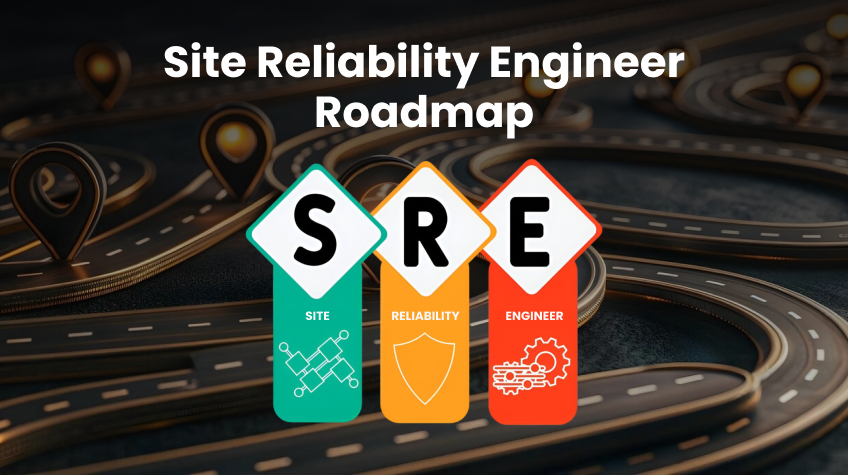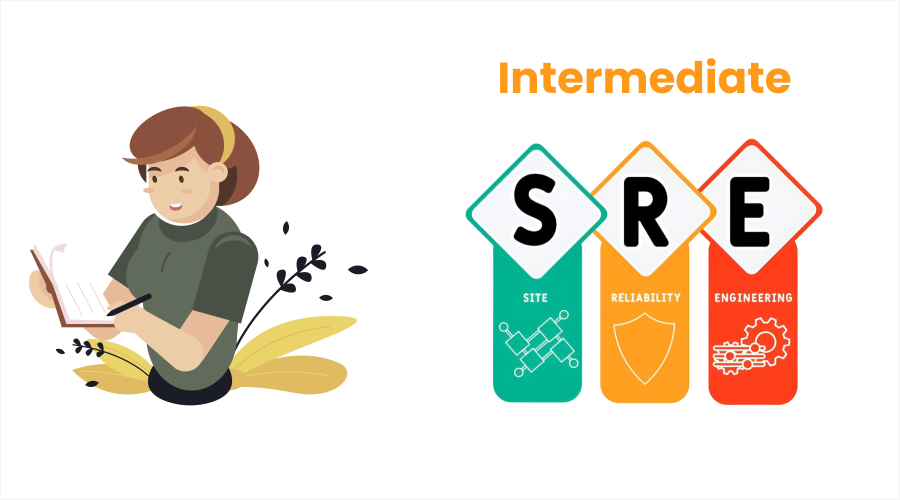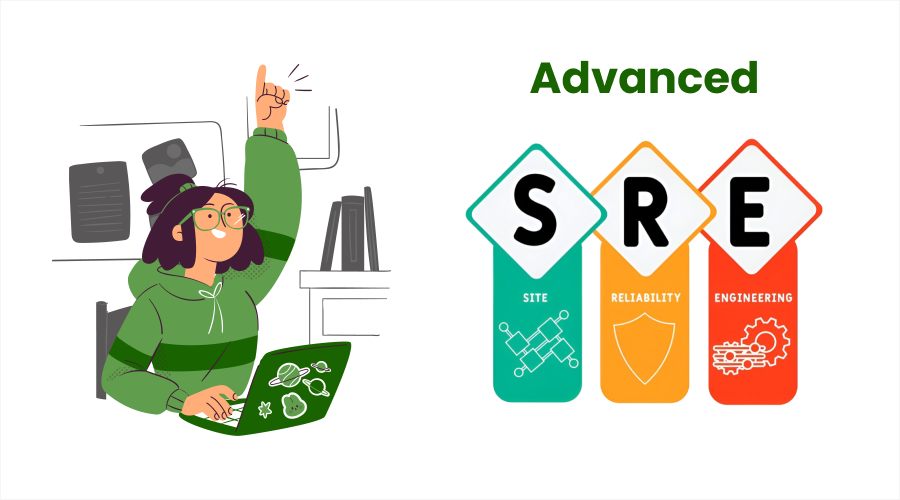
Site Reliability Engineer is one of the most important professions in contemporary IT and software development that effectively combines development and operation activities to achieve the proper functioning of systems. Originally drawn from software engineering and IT operations, SRE aims to build availability, scalability and efficiency into a system.
SREs originate from considering factors such as service availability, response to disturbances and the construction of reliable systems that can adequately cater to demand. Experienced SRE engineers add value in terms of monitoring and troubleshooting error-prone applications that form a stable and critical foundation of any organization’s internal and external activities and services in the current progressively complex digital context.
This informative guide highlights an SRE roadmap that provides a clear pathway to achieve success in this dynamic and critical role.
Phases to Become an SRE: Beginner, Intermediate, Advanced and Expert
To become a Site Reliability Engineer, one has to undergo several stages that help accumulate as well as enhance the knowledge and skills required for the post. Here’s an outline of the typical phases:
Phase 1: Beginner

It is equally exciting and challenging if you are starting your journey as an SRE in the industry. Here’s a SRE roadmap 2025 to help you navigate the beginner phase effectively:
1. Basic Linux/Unix Knowledge
It is noteworthy that SREs work on servers operating on Linux/Unix. Knowledge of these systems is important in the problem resolution and management of the system. Start with the basic commands of file manipulation (ls, cp, mv), process management (ps, kill) and text processing (grep, awk). Mastering file permissions (chmod, chown) and system monitoring tools like “top” and “stop” will help you debug issues.
2. Basic Programming & Scripting
Programming is useful for automation and scripting, as it is used to work and manage technology infrastructure. SRE uses Python, so start learning Python basics like loops, functions and handling files to enable the writing of simple scripts. Learning “Bash” scripting is vital when it comes to speedy and convenient system automation.
Memoirs to perform tasks such as checking disk space, reading logs or monitoring the health of the system work will work well for practice. However, as you advance further, you should switch to “Go” for constructing tools that are crucial to application performance.
3. Version Control (GitHub & GitLab)
Package control frameworks such as Git have to be applied when it is necessary to manage code and infrastructure modifications. Get familiar with the basic operations of Git which include, committing, branching, merging and handling conflict.
Applications like GitHub or GitLab support Git by bringing features like pull or merge requests, issue tracking and also CI/CD pipelines.
4. Basic Networking Concepts
An understanding of networks is important, as SRE is about guaranteeing that systems remain in contact with one another. Start with concepts like Domain Name System (DNS) and subnetting. Learn about web related protocols including TCP/IP protocol and HTTP/HTTPS protocol.
5. Understand the Basics of Cloud Platforms
AWS, GCP, Azure and similar cloud platforms nowadays constitute the core of most current and future facilities. Begin by signing up for their free editions to get started to create virtual machines and define storage services such as AWS S3 or Azure blob storage and VPC.
Phase 2: Intermediate

The intermediate phase in SRE is more about broadening your horizons about how to do SRE with scale, enhance automation and efficient monitoring and deployment systems.
1. Systems & Infrastructure
Enhance the knowledge of system architecture features, scale of distributed systems and its ability for redundancy as well as how it manages its failures. Learn about load balancing, caching and another failover mechanism.
2. Learn DevOps Basics
DevOps can’t be separated from software reliability engineering, so understand its key concepts such as collaboration, processes and tools. Learn CI/CD best practices for automating testing and deployment processes as it is done within Jenkins, GitLab CI/CD or GitHub Actions.
3. Automation & Configuration Management
Automation is affordable, less time consuming and more precise than doing it manually. Employ Ansible, Puppet or Chef for automation. Learn to write playbooks or recipes for specific tasks including deploying web servers, configuring databases or updating systems.
4. Monitoring & Logging
Monitoring functionality helps to maintain the well being and productivity of a system while logging is used for detecting problems. Learn the basics of monitoring tools like Prometheus and Grafana in serving real time metrics and alerting. Create dashboards that will reflect the most significant factors such as CPU usage, response time and failure rate.
5. Docker & Containers
Using containers makes it easier and more reliable to deploy and scale an application. To learn Docker, which is used for the creation, management and deployment of containerized applications. Make sure to check new ideas related to container networking, volumes concept and multi stage build.
Phase 3: Advanced

The advanced phase of SRE will involve mastering key practices for building scalable and reliable systems while also perfecting automation and incident response.
1. Service-Level Objectives (SLOs) & Indicators (SLIs)
Understand what reliability is and how to quantify it by using SLIs for which you set attainable SLOs to help drive performance. Apply these metrics to prioritize system reliability with development velocity and decide on what should be the next approach whether to pay technical debt or implement features.
2. Scalability & High Availability
Dive deeper into using efficiency in your designs of systems by using more infrastructural resources as loads rise. The topics to learn are load balancers, database sharding and caching. Learn patterns such as active-active and active-passive to have high availability and zero downtime during failover.
3. Cloud Platforms & Advanced Networking
Gain knowledge of auto scaling groups, server less functions as well as a managed Kubernetes service. Understand basic networking such as VPNs, private subnets, peering and CDN.
4. Incident Management & Root Cause Analysis
Incident management and root cause analysis help you become a brilliant incident handler by refining the detection, response and resolution. Understand post incident analysis and how to perform post mortems to determine the root causes of an incident and take corrective action.
5. Advanced Automation & Scripting
Refine your automation skills to effectively handle features within complex workflows and to optimize the management of infrastructure. Master scripting with Python or Go and API to perform companion tasks across multiple systems. Explore IaC solutions for Terraform and implement more complex CI/CD processes by using tools such as Jenkins or Spinnaker.
Also Read: DevOps Roles and Responsibilities
Phase 4: Expert

The expert phase in SRE focuses on expertise in system design, scaling the availability of systems and driving the culture of change that makes an organization better.
1. Advanced System Design
Utilise state of the art design and architectural principles that allow for the construction of large scale distributed systems for applications with very high intensities of load that have low rates of unavailability. Explore further into areas such as microservices, replication of data, eventuality and distributed consensus systems, for example, Paxos and Raft.
2. Resilience Engineering
Proactively build system reliability and incorporate resilience engineering principles. Also, learn chaos engineering experiments using tools such as Chaos Monkey to identify any weaknesses.
3. Capacity Planning & Performance Optimization
Master capacity planning to be able to forecast and control the system activity sufficiently. Learn historic trends to be able to accurately predict the demand and avoid resource constraints. Optimize queries, understand resources needed, gain more efficient allocation and other forms of profiling the performance.
4. Advanced Monitoring & Alerting
Apply the methodologies of identifying the key characteristics of exposure, susceptibility and response for varied and elaborate multiple interacting systems to create accurate monitoring techniques. Employ instruments like Jaeger or OpenTelemetry that will trace the delays occurring throughout consequential microservices.
5. Leadership & Mentoring
Become a technical leader by training the new junior SREs and working with other teams in a project leadership capacity. Transfer knowledge on how to work on the system through training the coders, having documentation and reviewing the code.
6. Security Best Practices
Integrate security in every layer of system design. Focus on secure authentication such as OAuth, SAML, encryption at rest and in transit and infusing security in infrastructure setups such as hardened instances and firewalls.
Also Read: Full Stack Developer Roadmap
Challenges Faced by SREs and How to Overcome Them
Here are the key challenges faced by SREs and how to overcome them:
1. Balancing Reliability and Development Speed
- Challenge: Offering features while keeping the system reliable at the same time.
- Solution: Set clear SLOs and introduce CI/CD pipelines for much faster & reliable deployments. Ensure automation of routine tasks to reduce toil.
2. Managing Complex, Distributed Systems
- Challenge: Increasing complexity in distributed systems.
- Solution: Introduce observability or metrics, logging and tracing. Utilize microservices with a modular design.
3. Incident Management and Response
- Challenge: Tackle the incidence quickly and decrease the impact.
- Solution: Chaos engineering and disaster recovery drills should be conducted. Runbooks must contain in depth details that help improve response.
4. Resource Management and Cost Optimization
- Challenge: Managing your clouds and their resources, while at the same time controlling their costs.
- Solution: Use auto scaling and serverless technologies. Implement regular audits to track cloud usage as a mechanism for optimization.
5. Ensuring Security and Compliance
- Challenge: Security of the system and compliance with the standards
- Solution: Implement security best practices and automate checks for compliance. Conduct security audits and penetration tests regularly.
Also Read: Rust Developer Roadmap
Conclusion
In conclusion, this roadmap for the Site Reliability Engineer provides a structured and clear pathway for professionals in this dynamic field. From foundational skills such as Linux, scripting and cloud platforms to moving through automation, monitoring and scalability, the roadmap guides individuals through key stages of growth.






